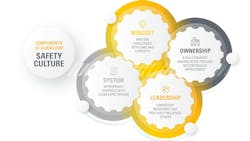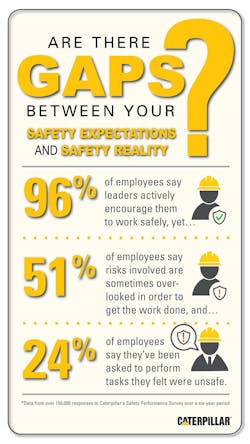Caterpillar Updates Safety Programs
Caterpillar Safety Services has updated two safety programs designed to build safety cultures within organizations: a safety perception survey and a program focused on human and organizational performance.
The survey analyzes an organization’s safety culture, and improvements include updates to language and modern concepts of safety culture excellence, adding questions related to psychological safety and human and organizational performance.
Read also: Mike Brennan, CEM, on how to develop a safety culture
Reports now include more modern visualization of the data. They measure five safety activities: hazard identification, event learning, inspections, near miss, and safety meetings. The updated survey addresses 11 cultural indicators, including caring climate, employee involvement, feedback, management credibility, training effectiveness and risk reduction. The indicators also show how safety is perceived differently among employees, supervisors, and managers, according to Caterpillar.
The performance program is a framework for talking about safety and creating a resilient safety culture. It helps organizations to build more error-tolerant systems by teaching leaders that expecting perfection from workers, processes, or procedures is not realistic. Traditional methods of managing safety systems center around designing policies, standard work, and processes assuming work happens in a straight line, according to Caterpillar. Management sets the expectations, tells workers what to do, and the workers do it the same way, every day.
This method does not account for organizational factors that can disrupt the system, according to Caterpillar, such as employees not having the right tools for the job and adapting or making tradeoffs because they are still required to meet production targets. Nor does it account for the individual factors that impact a worker’s awareness, or lapses in attention due to events in his or her personal life, such as a family emergency. When workers deviate from the safety plan or make mistakes under the traditional model, they may be scrutinized or punished to attempt to improve safety, but this can have the opposite effect and lead to a weaker safety culture.
In its 50th year of operation, Caterpillar Safety Services helps build a culture where safety practices are embedded across an organization. It defines four components of a resilient safety culture:
- System: clearly defined safety expectations embedded in policies and procedures to identify and mitigate risk.
- Mindset: a shared mindset that safety is everyone’s responsibility, people make mistakes and an environment of openness that makes people feel safe to speak up.
- Leadership: specific, consistent leadership behaviors at all levels of the organization that positively influence people toward safe work.
- Ownership: occurs when all levels fully engage in the creation and continuous improvement of the safety system.
About the Author
Rod Sutton
Sutton has served as the editorial lead of Construction Equipment magazine and ConstructionEquipment.com since 2001.
Our mission is to help managers of heavy equipment and trucks to improve their performance in acquiring and managing their fleets. One way we do that is with our Executive Institute, where experts share information and ideas that will enable equipment managers to accurately manage equipment costs so that they can deliver the optimum financial benefits to their organizations.
We also have a laser focus on product development, performance, and technology; as well as equipment acquisition, disposal, and maintenance. Our exclusive Field Tests take earthmoving equipment and truck into the field for professional evaluations.
Check out our free newsletters to see the latest content.
You can find Sutton on LinkedIn.


